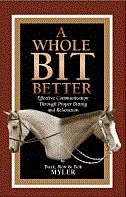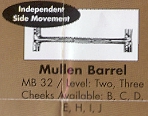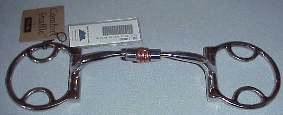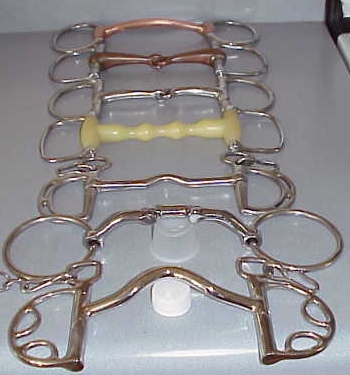Icelandic Horse
Connection
Bits and Bitting
Book by the Myler Brothers:
Dale, Ron, and Bob

Here are some photos of different bits:

It's a bit difficult to see that it's a mullen in
Myler's brochure.
The angle of the
photo makes it look straight.

A Myler double jointed snaffle with lifted roller.

Myler D-ring double-jointed snaffle with centered copper roller.

Myler Curb and a Sleister Curb
Notice the bend in the mouthpiece of the Myler bits.

From the top: Copper mullen mouth eggbutt, Copper D-ring snaffle, D-ring snaffle, Happy Mouth, Kimberwicke, Myler double jointed O-ring snaffle, Myler curb.
Width of the Bit
Ordinary single jointed snaffles should be fitted to allow approximately one
quarter inch clearance between the bit ring and the horse's lips. Fitting
too closely to the lips can result in pinching, but a snaffle bit that is
too wide (a more common occurance) will slide across the horse's mouth from
one side to the other and can easily result in bruising of the bars, tongue
and/or lips.
Double jointed bits, such as the KK Training BitT are fitted more closely to
the actual physical width of the horse's mouth. The extra joint causes the
bit to dangle in the horse's mouth and the rings will hang very close to the
lips - regardless of the width of the bit. Thus it is necessary to fit the
bit very closely and it will be held straight across the mouth. Modern bit
rings very seldom cause any pinching problems although horses with thick,
fleshy lips my be rubbed by a loosering bit adjusted in this way. These
horses are better fitted with an eggbutt style double jointed bit.
Shape of the Bit
A bit with a curve to both halves of the mouthpiece conforms better to the
shape of the horse's lower jaw than a straight mouthpiece. It is also less
likely to allow the joint, in the case of an ordinary single jointed
snaffle, to push up into the horse's palate - a very uncomfortable
situation, as you can imagine!
Wonder Bit
A wonder bit is a modified gag -- as such it has very limited application in
good horsemanship or riding. With this bit, any pressure on the reins
causes the mouthpiece to rise in the mouth, pulling on the corners of the
lips --a very sensitive area-- and the poll, as well as putting pressure on
the jaw from the curb chain. The only really legitimate use of such a
contraption is to raise the head of a horse that tends to get behind the
bit -- and then only to be used for a short time until the horse learns
other habits and can be put in a bit that actually has some useful training
function.
The illegitimate uses are myriad, however -- including creating head nod on
a horse that has none.
This bit does nothing for teaching self carriage, nothing for teaching
lateral flexion, nothing for teaching the horse to work through his body,
and nothing for teaching the basic " calm, obedient, forward, straight,
supple and light" which are the goals of good horsemanship everywhere.
So, I don't like them ... I am also not fond of watching horses suffer
through being forced to back up in one. For some unknown reason this thing
has become the "bit du jour" in some circles, replacing the loose jawed curb,
which itself replaced the fixed S shank curb. Fads change, good
horsemanship doesn't.
Contact Us
|